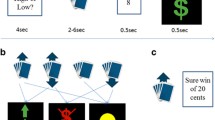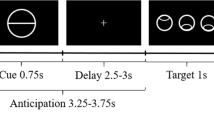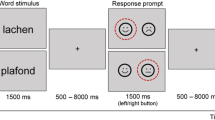Abstract
Greedy individuals often exhibit more impulsive decision-making and short-sighted behaviors. It has been assumed that altered reward circuitry and prospection network is associated with greed personality trait (GPT). In this study, we first explored the morphological characteristics (i.e., gray matter volume; GMV) of GPT combined with univariate and multivariate pattern analysis (MVPA) approaches. Second, we adopted a revised version of inter-temporal choice task and independently manipulated the amount and delay time of future rewards. Using brain-imaging design, reward- and prospection-related brain activations were assessed and their associations with GPT were further examined. The MVPA results showed that GPT was associated with the GMVs in the right lateral frontal pole cortex, left ventromedial prefrontal cortex, right lateral occipital cortex, and right occipital pole. Additionally, we observed that the amount-relevant brain activations (responding to reward circuitry) in the lateral orbitofrontal cortex were negatively associated with individual’s variability in GPT scores, whereas the delay time-relevant brain activations (responding to prospection network system) in the dorsolateral prefrontal cortex, dorsomedial prefrontal cortex, superior parietal lobule, and anterior cingulate cortex were positively associated with individual’s variability in GPT scores. These findings not only provide novel insights into the neuroanatomical substrates underlying the human dispositional greed, but also suggest the critical roles of reward and prospection processing on the greed.



Similar content being viewed by others
Data availability statement
The data that support the findings of this study are available from the corresponding author upon reasonable request.
References
Aimran W, Setia A, Basri A (2014) Engaging structureal greed today: Christians and Muslims in Dialogue. Islamic Sciences 12(1):61–110
Anderson VM, Fernando KT, Davies GR, Rashid W, Frost C, Fox NC, Miller DH (2007) Cerebral Atrophy Measurement in Clinically Isolated Syndromes and Relapsing Remitting Multiple Sclerosis: A Comparison of Registration-Based Methods. J Neuroimaging 17(1):61–68
Badre D, Doll BB, Long NM, Frank MJ (2012) Rostrolateral Prefrontal Cortex and Individual Differences in Uncertainty-Driven Exploration. Neuron 73(3):595–607
Badre D, Nee DE (2018) Frontal Cortex and the Hierarchical Control of Behavior. Trends Cogn Sci 22(2):170–188
Ballard K, Knutson B (2009) Dissociable neural representations of future reward magnitude and delay during temporal discounting. Neuroimage 45(1):143–150
Bechara A, Damasio AR (2005) The somatic marker hypothesis: A neural theory of economic decision. Games and economic behavior 52:336–372
Bickel WK, Odum AL, Madden GJ (1999) Impulsivity and cigarette smoking: delay discounting in current, never, and ex-smokers. Psychopharmacology 146(4):447–454
Blumenfeld RS, Ranganath C (2007) Prefrontal Cortex and Long-Term Memory Encoding: An Integrative Review of Findings from Neuropsychology and Neuroimaging. Neuroscientist 13(3):280–291
Braver TS, Cole MW, Yarkoni T (2010) Vive les differences! Individual variation in neural mechanisms of executive control. Curr Opin Neurobiol 20(2):242–250
Bruhn JG, Lowrey J (2012) The good and bad about greed: How the manifestations of greed can be used to improve organizational and individual behavior and performance. Consulting Psychology Journal: Practice and Research 64(2):136–150
Constantinople CM, Piet AT, Bibawi P, Akrami A, Kopec C, Brody CD (2019) Lateral orbitofrontal cortex promotes trial-by-trial learning of risky, but not spatial, biases. eLife 2019 (8):e49744
Dale AM (1999) Optimal experimental design for event-related fMRI. Hum Brain Mapp 8(2):109–114
Damasio AR (1996) The somatic marker hypothesis and the possible functions of the prefrontal cortex. Philosophical Transactions of the Royal Society B Biological Sciences 351(1346):1413–1420
Daw ND, O’doherty J, Dayan P, Seymour B, Dolan RJ, (2006) Cortical substrates for exploratory decisions in human. Nature 441:876–879
Dominguez VR (2014) The Rich Possibilities of Greed and Excess. Economic Anthropology 1(1):193–199
Drucker H, Burges CJ, Kaufman L, Smola AJ, Vapnik V Support vector regression machines. In: Advances in neural information processing systems, 1997. pp 155–161
Dubois J, Adolphs R (2016) Building a Science of Individual Differences from fMRI. Trends Cogn Sci 20(6):425–443
Elliott AJ, Thrash TM (2002) Approach-avoidance motivation in personality: Approach and avoidance temperaments and goals. J Pers Soc Psychol 82(5):804–818
FitzGerald TH, Seymour B, Dolan RJ (2009) The Role of Human Orbitofrontal Cortex in Value Comparison for Incommensurable Objects. J Neurosci 29(26):8388–8395
Gable SL (2006) Approach and Avoidance Social Motives and Goals. J Pers 74(1):175–222
Gallagher HL, Frith CD (2003) Functional imaging of “theory of mind.” Trends Cogn Sci 7(2):77–83
Grady CL, Rieck JR, Nichol D (2021) Rodrigue KM (2021) Influence of sample size and analytic approach on stability and interpretation of brain-behavior correlations in task-related fMRI data. Hum Brain Mapp 42:204–219
Grill-Spector K, Malach R (2004) The human visual cortex. Annu Rev Neurosci 27:649–677
Haber SN, Knutson B (2010) The Reward Circuit: Linking Primate Anatomy and Human Imaging. Neuropsychopharmacology 35:4–26
Hanke M, Halchenko YO, Sederberg PB, Hanson SJ, Haxby JV, Pollmann S (2009) PyMVPA: a Python Toolbox for Multivariate Pattern Analysis of fMRI Data. Neuroinformatics 7:37–53
Hare TA, Camerer CF, Rangel A (2009) Self-Control in Decision-making Involves Modulation of the vmPFC Valuation System. Science 324(5927):646–648
Harrington DL, Haaland KY, Knight RT (1998) Cortical Networks Underlying Mechanisms of Time Perception. J Neurosci 18(3):1085–1095
Haxby JV (2012) Multivariate pattern analysis of fMRI: the early beginnings. Neuroimage 62(2):852–855
Haxby JV, Connolly AC, Guntupalli JS (2014) Decoding neural representational spaces using multivariate pattern analysis. Annu Rev Neurosci 37:435–456
Henningsgaard JM, Arnau RC (2008) Relationships between religiosity, spirituality, and personality: A multivariate analysis. Personality Individ Differ 45(8):703–708
Jenkinson M, Smith SM (2001) A global optimisation method for robust affine registration of brain images. Med Image Anal 5(2):143–156
Jimura K, Poldrack RA (2012) Analyses of regional-average activation and multivoxel pattern information tell complementary stories. Neuropsychologia 50(4):544–552
Kable JW, Glimcher PW (2007) The neural correlates of subjective value during intertemporal choice. Nat Neurosci 10(12):1625
Krekels G, Pandelaere M (2015) Dispositional greed. Personality Individ Differ 74:225–230
Kriegeskorte N, Goebel R, Bandettini P (2006) Information-based functional brain map**. Proc Natl Acad Sci USA 103(10):3863–3868
Kringelbach ML, Rolls ET (2004) The functional neuroanatomy of the human orbitofrontal cortex: evidence from neuroimaging and neuropsychology. Prog Neurobiol 72(5):341–372
Krueger RF, Markon KE, Patrick CJ, Benning SD, Kramer MD (2007) Linking antisocial behavior, substance use, and personality: An integrative quantitative model of the adult externalizing spectrum. J Abnorm Child Psychol 116(4):645–666
Kühn S, Gallinat J (2012) The neural correlates of subjective pleasantness. Neuroimage 61(1):289–294
Lara AH, Wallis JD (2015) The Role of Prefrontal Cortex in Working Memory: A Mini Review. Front Syst Neurosci 9 (173)
Laureiro-Martinez D, Brusoni S, Canessa N, Zollo M (2015) Understanding the exploration-exploitation dilemma: An fMRI study of attention control and decision-making performance. Strateg Manag J 36(3):319–338
Lebreton M, Bertoux M, Boutet C, Lehericy S, Dubois B, Fossati P, Pessiglione M (2013) A Critical Role for the Hippocampus in the Valuation of Imagined Outcomes. PLoS Biol 11(10):e1001684
Levine DP (2000) The attachment of Greed to Self-Interest. Psychoanalytic Studies 2(2):131–140
Levy DJ, Glimcher PW (2012) The root of all value: a neural common currency for choice. Curr Opin Neurol 22(6):1027–1038
Li N, Ma N, Liu Y, He X-S, Sun D-L, Fu X-M, Zhang X, Han S, Zhang D-R (2013) Resting-state functional connectivity predicts impulsivity in economic decision-making. J Neurosci 33(11):4886–4895
Li W, Wang H, **e X, Li J (2019) Neural mediation of greed personality trait on economic risk-taking. eLife 8:e45093
Lim S-L, O’Doherty J, Rangel A (2011) The Decision Value Computations in the vmPFC and Striatum Use a Relative Value Code That is Guided by Visual Attention. J Neurosci 31(37):13214–13223
Mussel P, Hewig J (2016) The life and times of individuals scoring high and low on dispositional greed. J Res Pers 64:52–60
Mussel P, Hewig J (2019) A neural perspective on when and why trait greed comes at the expense of others. Scientific Reports 9:10985
Mussel P, Reiter AM, Osinsky R, Hewig J (2015) State- and trait-greed, its impact on risky decision-making and underlying neural mechanisms. Soc Neurosci 10(2):1–9
Mussel P, Rodrigues J, Krumm S, Hewig J (2018) The convergent validity of five dispositional greed scales. Personality Individ Differ 131:249–253
Norman KA, Polyn SM, Detre GJ, Haxby JV (2006) Beyond mind-reading: multi-voxel pattern analysis of fMRI data. Trends Cogn Sci 10(9):424–430
Nostro AD, Muller VI, Varikuti DP, Plaschke RN, Hoffstaedter F, Langner R, Patil KR, Eickhoff SB (2018) Predicting personality from network-based resting-state functional connectivity. Brain Struct Funct 223:2699–2719
O’doherty J, Kringelbach ML, Rolls ET, Hornak J, Andrews C, (2001) Abstract reward and punishment representations in the human orbitofrontal cortex. Nat Neurosci 4:95–102
Okuda J, Fujii T, Ohtake H, Tsukiura T, Tanji K, Suzuki K, Kawashima R, Fukuda H, Itoh M, Yamadori A (2003) Thinking of the future and past: the roles of the frontal pole and the medial temporal lobes. Neuroimage 19(4):1369–1380
Öngür D, Ferry AT, Price JL (2003) Architectonic subdivision of the human orbital and medial prefrontal cortex. J Comp Neurol 460(3):425–449
Patrick CJ, Hicks BM, Krueger RF, Lang AR (2005) Relations between Psychopathy Facets and Externalizing in a Criminal Offender Sample. J Pers Disord 19(4):339–356
Peters J, Büchel C (2010a) Episodic Future Thinking Reduces Reward Delay Discounting through an Enhancement of Prefrontal-Mediotemporal Interactions. Neuron 66(1):138–148
Peters J, Büchel C (2010b) Neural representations of subjective reward value. Behav Brain Res 213(2):135–141
Peters J, Büchel C (2011) The neural mechanisms of inter-temporal decision-making: understanding variability. Trends Cogn Sci 15(5):227–239
Riccelli R, Toschi N, Nigro S, Terracciano A, Passamonti L (2017) Surface-based morphometry reveals the neuroanatomical basis of the five-factor model of personality. Soc Cogn Affect Neurosci 12(4):671–684
Ritchie JB, Kaplan DM, Klein C (2019) Decoding the Brain: Neural Representation and the Limits of Multivariate Pattern Analysis in Cognitive Neuroscience. Br J Philos Sci 70(2):581–607
Rokeach M (1973) The nature of human values.
Saxe R, Haushofer J (2008) For Love or Money: A Common Neural Currency for Social and Monetary Reward. Neuron 58(2):164–165
Schachar DL, Addis DR, Buckner RL (2007) Remembering the past to imagine the future: the prospective brain. Nat Rev Neurosci 8:657–661
Schneider B, Koenigs M (2017) Human lesion studies of ventromedial prefrontal cortex. Neuropsychologia 107:84–93
Schwartz SH (1992) Universals in the content and structure of values: Theory and empirical tests in 20 countries. In M Zanna (Ed), Advances in experimental social psychology 25. doi:https://doi.org/10.1016/S0065-2601(08)60281-6
Seaman KL, Brooks N, Karrer TM, Castrellon JJ, Perkins SF, Dang LC, Hsu M, Zald DH, Samanez-Larkin GR (2018) Subjective value representations during effort, probability and time discounting across adulthood. Soc Cogn Affect Neurosci 13(5):449–459
Seuntjens TG, van de Ven N, Zeelenberg M, van der Schors A (2016) Greed and adolescent financial behavior. J Econ Psychol 57:1–12
Seuntjens TG, Zeelenberg M, van de Ven N, Breugelmans SM (2015) Dispositional greed. J Pers Soc Psychol 108(6):917–933
Shaw P, Kabani NJ, Lerch JP, Echstrand K, Lenroot RK, Gogtay N, Greenstein D, Clasen L, Evans A, Rapoport JL, Giedd J, Wise SP (2008) Neurodevelopmental Trajectories of the Human Cerebral Cortex. J Neurosci 28(14):3586–3594
Sjåstad H (2019) Short-sighted greed? Focusing on the future promotes reputation-based generosity. Judgm Decis Mak 14(2):199–213
Sripada CS, Gonzalez R, Phan KL, Liberzon I (2011) The neural correlates of intertemporal decision-making: Contributions of subjective value, stimulus type, and trait impulsivity. Hum Brain Map** 32(10):1637–1648
Tang TLP (2007) Income and Quality of Life: Does the Love of Money Make a Difference? J Bus Ethics 72:375–393
Tanji J, Hoshi E (2001) Behavioral planning in the prefrontal cortex. Curr Opin Neurobiol 11(2):164–170
Teicher MH, Samson JA, Anderson CM, Ohashi K (2016) The effects of childhood maltreatment on brain structure, function and connectivity. Nat Rev Neurosci 17 (652–666)
Tom SM, Fox CR, Trepel C, Poldrack RA (2007) The Neural Basis of Loss Aversion in Decision-Making Under Risk. Science 315(5811):515–518
van Noordt SJ, Segalowitz SJ (2012) Performance monitoring and the medial prefrontal cortex: a review of individual differences and context effects as a window on self-regulation. Front Hum Neurosci 6:197
Veselka L, Giammarco EA, Vernon PA (2014) The Dark Triad and the seven dealy sins. Personality Individ Differ 67:75–80
Wang L, Murnighan JK (2011) On Greed. Acad Manag Ann 5(1):279–316
Wang Q, Chen C, Cai Y, Li S, Zhao X, Zheng L, Zhang H, Liu J, Chen C, Xue G (2016) Dissociated neural substrates underlying impulsive choice and impulsive action. Neuroimage 134:540–549
Wang Q, Luo S, Monterosso J, Zhang J, Fang X, Dong Q, Xue G (2014) Distributed value representation in the medial prefrontal cortex during intertemporal choices. J Neurosci 34(22):7522–7530
Wang Q, Lv C, He Q (2020a) Xue G (2020a) Dissociable fronto-striatal functional networks predict choice impulsivity. Brain Struct Funct 225:2377–2386
Wang Q, Poh JS, Wen DJ, Broekman BF, Chong YS, Yap F, Shek L, Gluckman PD, Fortier MV, Qiu A (2019a) Functional and structural networks of lateral and medial orbitofrontal cortex as potential neural pathways for depression in childhood. Depress Anxiety 36(4):365–374
Wang Q, Zhang H, Poh JS, Pecheva D, Broekman BF, Chong YS, Shek L, Gluckman PD, Fortier MV, Heaney M, Qiu A (2020b) Sex-Dependent Associations among Maternal Depressive Symptoms, Child Reward Network, and Behaviors in Early Childhood. Cereb Cortex 30(3):901–912
Wang Q, Zhang H, Wee C-Y, Lee A, Poh JS, Chong YS, Tan KH, Gluckman PD, Yap F, Fortier MV, Rifkin-Graboi A, Qiu A (2019b) Maternal sensitivity predicts anterior hippocampal functional networks in early childhood. Brain Struct Funct 224(5):1885–1895
Wang Q, Zhu Y, Wang Y, Chen C, He Q, Xue G (2020c) Intrisic non-hub connectivity predicts human inter-temporal decision-making. Brain Imaging and Behavior 0 (0):1–12
Wittmann M, Paulus MP (2008) Decision making, impulsivity and time perception. Trends Cogn Sci 12(1):7–12
Xue G, Lu Z-L, Levin IP, Weller JA, Li X, Antoine B (2009) Functional Dissociations of Risk and Reward Processing in the Medial Prefrontal Cortex. Cereb Cortex 19(5):1019–1027
Funding
This work was supported by research grants from the Humanities and Social Science Fund Project of the Ministry of Education (Grant No. 20YJC190018), Major Project of National Social Science Foundation of China (20ZDA079), and National Natural Science Foundation of China (Grant Nos. 32000786, 31800920).
Author information
Authors and Affiliations
Corresponding author
Ethics declarations
Conflict of interest
The authors declare that they have no conflict of interest.
Ethical approval
All procedures performed in studies involving human participants were in accordance with the ethical standards of the Institutional Review Board (IRB) of the Tian** Normal University and with the 1964 Helsinki declaration and its later amendments or comparable ethical standards. Informed consent was obtained from all participants included in the study
Informed consent
Informed consent was obtained from all individual participants included in the study.
Additional information
Publisher's Note
Springer Nature remains neutral with regard to jurisdictional claims in published maps and institutional affiliations.
Supplementary Information
Below is the link to the electronic supplementary material.
Rights and permissions
About this article
Cite this article
Wang, Q., Wei, S., Im, H. et al. Neuroanatomical and functional substrates of the greed personality trait. Brain Struct Funct 226, 1269–1280 (2021). https://doi.org/10.1007/s00429-021-02240-9
Received:
Accepted:
Published:
Issue Date:
DOI: https://doi.org/10.1007/s00429-021-02240-9




